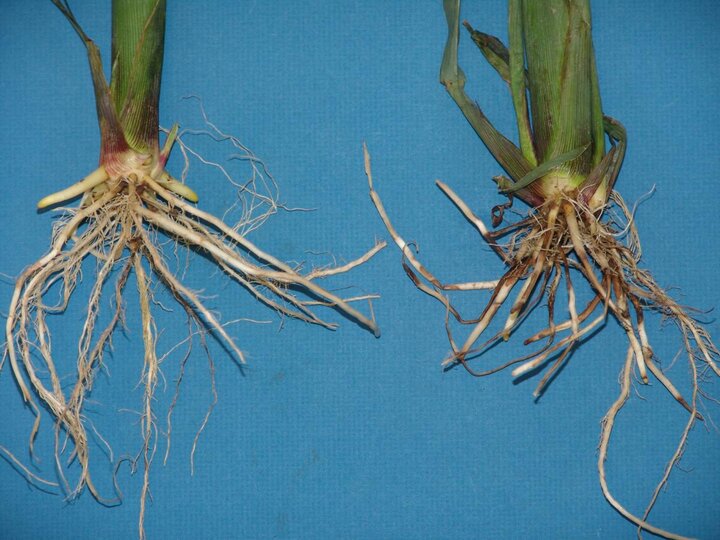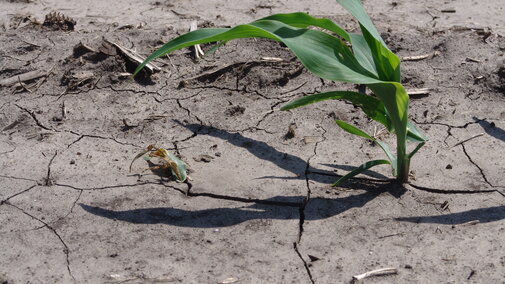Recent cold, wet field conditions and fluctuations in soil temperatures have put early planted corn at risk for seedling disease development. Cold soil temperatures and episodes of recent rainfall (and snow) are especially favorable for some of the most common and damaging seedling diseases favored by cold wet conditions. Numerous seedling diseases can take advantage of any of these conditions. Be sure to monitor seedling emergence and stand establishment in the coming weeks so if problems occur they can be detected as early as possible.
Seedling diseases can be caused by any of several common soilborne organisms, such as Pythium, Fusarium, Rhizoctonia or plant parasitic nematodes. Seedling diseases are often difficult to diagnose because their symptoms are very similar. Sometimes, diagnosis may be of limited value because management is often the same for several seedling diseases. Microscopic examination and other laboratory analyses of the diseased seedlings can often identify the cause(s) of the problems. Also, seedling diseases can be confused with insect injury, herbicide damage, planting problems, or environmental stresses that often have similar symptoms.
Possible symptoms of seedling diseases include:
- Rotted seed prior to germination
- Rotted or discolored seedlings after germination prior to emergence
- Post-emergence seedling damping off (Figure 1)
- Root or hypocotyl decay (Figures 2 and 3)
At least 14 species of Pythium have been identified that can cause seedling blight and root rot. These pathogens require excessive moisture because they produce motile swimming zoospores that infect plant roots. The pathogen overwinters in soil and infected plant debris by producing thick-walled oospores that can survive for several years in the absence of a suitable host and favorable weather conditions. In addition to wet soil conditions, some species of Pythium are favored by cold soil conditions and are most likely to cause seed and seedling diseases lately.

At least six Fusarium species can cause seedling diseases and root rots and several are common in Nebraska fields. Stressed plants due to weather extremes (temperature and moisture), herbicide damage, and physical injury are more prone to infection and disease caused by Fusarium species.
Rhizoctonia species can also cause seedling diseases, but tend to be more common in drier growing conditions. Rhizoctonia tends to cause reddish-brown lesions (Figure 3) that can girdle and rot off roots. Root and crown rot may be severe enough to cause seedling death.
Management
Unfortunately, hybrid resistance is not available for seedling diseases in corn. Where practical and in cases where flooding is a frequent concern, improved field drainage can help reduce the incidence and severity of some seedling diseases. Waiting to plant until soil conditions are warmer can promote rapid seed germination and emergence and help plants avoid infection and disease development. The most common method for disease management is the use of seed treatment fungicides.
Crop rotation can provide some reduction in disease, but some of the pathogens may also infect soybean and other crops.

Figure 3. Root lesions and decay (right) compared to apparently healthy plant (left) with no evident discoloration or lesions,
Most seed corn is already treated with more than one seed treatment fungicide, often an insecticide, and, sometimes with a nematicide. These products can provide protection against some of the pathogens that cause seedling diseases; however, they only provide protection during the first few weeks immediately after planting. But, in spite of their activity, diseases may still develop, such as during extended periods of inclement weather or under severe pathogen pressure.
Some fungicides now also are labeled for application in-furrow at planting. Use of fungicides in-furrow at planting may provide some additional protection against these pathogens in fields with severe pathogen pressure and chronic seedling diseases, but more research needs to be conducted to better predict their potential benefits and economic return.
You can minimize the likelihood of developing seedling diseases by planting high quality seed at appropriate planting depths and soil conditions to support rapid plant growth and emergence.

